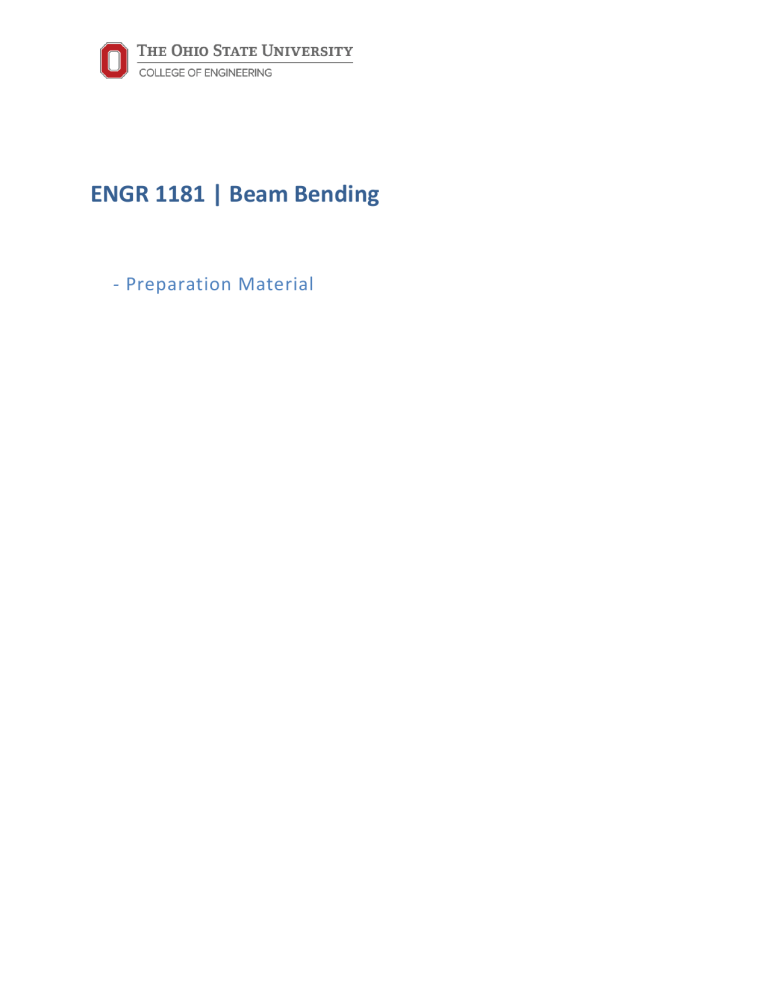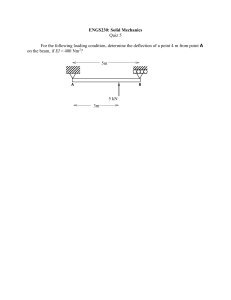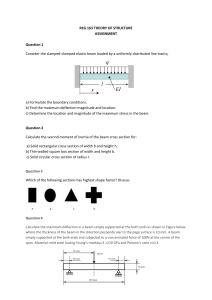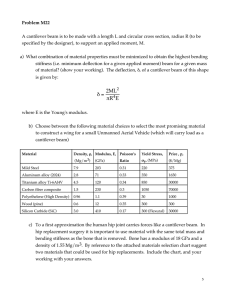
ENGR 1181 | Beam Bending
- Preparation Material
ENGR 1181 Lab 5: Beam Bending
Preparation Material
Preparation Material
2
ENGR 1181 Lab 5: Beam Bending
Preparation Material
• Overview of the Beam Bending Lab
The Beam Bending Lab introduces basic data collection and analysis techniques, using concepts
that engineers use to design structures, including material selection and design configurations.
Students will review this document and watch a dial caliper video before arriving at lab.
Learning Objectives – In the Beam Bending Lab you will be able to:
1. Accurately measure dimensions and deflections.
2. Utilize Microsoft Excel for engineering tasks.
3. Apply theoretical concepts, such as stress and strain, to make predictions about material
behaviors.
4. Calculate physical properties from measured values, including moment of inertia and
Young's modulus.
5. Evaluate empirical findings based on error calculations.
6. Identify an unknown beam material through observation, calculation, and engineering
judgement.
• Engineering Structures
This lab explores data collection and analysis in an engineering application of materials and
structures. If the connection between these two areas is not obvious, consider this.
Engineers design and build all sorts of structures that must be useful, efficient, and safe. These
range from the very small - nanotechnology devices and computer chips – to very large – airplanes,
bridges, and tall buildings. Depending on the goal, the material used, be it metal, plastic, glass,
concrete, etc., will greatly affect the structure being designed. Engineers must be certain of their
expected outcomes so that the structures they design will be stable and safe under the most
adverse operating conditions, and they build this certainty by comparing new data that they collect
to known theory.
In this lab, the new data will revolve around how far structural beams will bend when different,
discrete amounts of force are applied. To be able to apply this, let's investigate what is already
known about how structural materials behave when they are subjected to different forces.
Force and Deflection for a Simple Spring
You likely learned in physics that an applied force, F, makes a spring stretch (or compress) by the
distance x. The linear relationship between F and x is Hooke's Law:
𝐹 =𝑘∙𝑥
(1)
where k is called the spring constant. Note that for large values of the spring constant, the spring
stretches only a small amount in response to an applied force.
In SI units, the force F is in Newtons, distance x is in meters, and the spring constant has units of
N/m.
In English units, F is in lbf (pounds-force), x is in inches, and the spring constant has units of lbf/in.
3
ENGR 1181 Lab 5: Beam Bending
Preparation Material
Simplified Model of Structural Materials
By collecting and analyzing experimental data, scientists and engineers have found that solid
materials also exhibit an elastic, spring-like response to applied forces. Figure 1a (below) shows an
aluminum rod with cross-section area A and initial length L when no force is applied. The atoms in
the rod are all connected to their nearest neighbors by electromagnetic forces that are "spring-like"
– here shown as atoms connected by springs.
F
F
Area, A
L
L+ L
L
F
F
Figure 1b. Aluminum Bar, Force F
Figure 1a. Aluminum Bar, no Force
Figure 1: Aluminum Bar with and without an Applied Force
Figure 1b shows the same aluminum rod, but with two opposing forces F applied at each end. In
response to the forces, the length of the aluminum bar increases (stretches) by an amount ΔL.
When the forces pull outward, as shown in Figure 1b, the bar is said to be in "tension".
If both forces were reversed to push inward on the ends of the bar, the length of the bar decreases
by the same amount ΔL and we would say that the bar is in "compression".
Stress, Strain and Young's Modulus
For Figure 1, the "spring-like equation" for the aluminum bar is
𝐹
𝛥𝐿
=𝐸∙
𝐴
𝐿
(2)
The proportionality constant E is called Young's modulus, or the modulus of elasticity, and has units
of N/m2 (Pascals) or lbf/in2 (pounds per square inch, or simply psi).
The ratio "F/A" is called "stress" and is given the Greek letter symbol σ (“Sigma”):
Stress
𝜎=
𝐹
𝐴
{
𝑁
(𝑃𝑎𝑠𝑐𝑎𝑙𝑠)
𝑚2
𝑜𝑟
𝑙𝑏𝑓
(𝑝𝑠𝑖) }
𝑖𝑛2
(3)
The physical interpretation of stress is: the internal pressure in the aluminum bar caused by
externally applied forces.
4
ENGR 1181 Lab 5: Beam Bending
Preparation Material
The ratio "ΔL/L" is called "strain" (dimensionless) and is given the Greek letter ε (“Epsilon”):
Strain
𝜀=
𝛥𝐿
𝐿
{
𝑚
𝑖𝑛
𝑜𝑟
𝑚
𝑖𝑛
(𝑑𝑖𝑚𝑒𝑛𝑠𝑖𝑜𝑛𝑙𝑒𝑠𝑠) }
(4)
Therefore, strain is the fractional elongation (or compression) of a structural member caused by
applied forces. For instance, a strain of ε = 0.025 would correspond to a 2.5% increase in the length
of the bar.
Substituting Equations (3) and (4) into (2) gives the fundamental "stress-strain" equation for
materials:
𝜎 =𝐸∙𝜀
{
𝑁
(𝑃𝑎𝑠𝑐𝑎𝑙𝑠) 𝑜𝑟
𝑚2
𝑙𝑏𝑓
(𝑝𝑠𝑖) }
𝑖𝑛2
(5)
The relationships described by these equations help engineers make accurate predictions about the
structures they design. These equations tell us that, if an object’s Young’s Modulus is very large, the
force needed to elongate or compress it must also be very large. Most structural materials (steel,
etc.) are chosen because they have this property, meaning large forces will cause only small
deformations. Have you ever been in a car on a bridge and felt the slight up-and-down motion of
the bridge caused by heavy trucks moving across it?
Metric and English values of Young's modulus for example materials, some of which are used in the
Beam Bending Lab, are shown in Table 1. Notice that carbon steel is roughly three times stronger
than aluminum, meaning that it would take three times as much stress to produce the same strain.
Table 1: Young’s Modulus (E) for Various Materials
Material
Young's modulus, E
GPa (109 N/m2)
psi (lbf/in2)
Polystyrene
3
435,000
Basswood
35
5,000,000
Aluminum
70
10,000,000
Carbon Fiber
70
10,000,000
Titanium
105
15,000,000
Copper
130
18,900,000
Steel (carbon)
210
30,000,000
Diamond
1050
150,000,000
5
ENGR 1181 Lab 5: Beam Bending
Preparation Material
Stress-Strain Graphs and Structural Failure
Figure 2 shows the graph of stress versus strain for a typical structural material. The linear portion
of the curve (up to point 2) is called the elastic region, because every time the force is removed, the
beam returns to its original length. The slope of the linear portion of the curve is equal to Young's
modulus, as per Equation (5) above. Point 2 is called the Proportional Limit.
Figure 2: Graph of Stress vs. Strain
After Point 2, however, the curve becomes non-linear, and the beam will be permanently deformed.
The graph also shows that if the beam is stressed to Point 4 and the force is removed, then the beam
retains a permanent 0.2% elongation. If the beam is stretched to the end of the curve, the beam
fails completely and breaks apart.
In many cases, engineers design structures so that the maximum stress in buildings or airplanes
will never exceed the Proportional Limit (Point 2), even under the most adverse conditions.
Professional design standards, building codes and governmental regulations also require structural
engineers to use safety factors in the design of bridges, buildings, airplanes, and other critical
structures. The stress applied in this lab will not strain any beams past Point 2.
Because Young’s Modulus is a property of the material, when base geometric factors (the A, and Ls
of stress and strain), forces, and changes are known, then Young’s Modulus could be calculated, and
the material identified. The scenarios in the next few pages will make measurements easier.
6
ENGR 1181 Lab 5: Beam Bending
Preparation Material
• Cantilever Beams
Horizontal Cantilever Beam
While force along the length of a structure is important to consider, many applications involve
forces applied across the length of a structure. A common model for this is a cantilever beam, a
structure with one end firmly anchored and the other end free to move. Figure 3 shows a cantilever
beam with the beam oriented in a horizontal plane.
The free end of the beam will move down if an
external force F (such as gravity) is applied to the end.
Note that this force is perpendicular to the length of
the beam, rather than along it. The deflection of the
free end of the beam due to the applied force F
depends on: (1) the dimensions of the beam (length L,
width w, and thickness t), (2) Young's modulus (E) for
the beam material, and (3) a geometry factor called
the Moment of Inertia.
Examples of horizontal cantilevers are:
•
•
•
Figure 3: Horizontal Cantilever Beam
airplane wings
diving boards
the overhanging section of the upperlevel deck in Ohio Stadium.
Unlike the first scenario, the force F does not change the beam length, but causes the end of the
beam to deflect downward by an amount δ (delta). The equation to calculate the deflection δ is:
“Spring-Like”
Equation
Deflection
𝐹
𝛿
= 𝐸∗ 3
3∗𝐼
𝐿
𝛿 =
𝐹𝐿3
3𝐸𝐼
(6)
{ 𝑚 𝑜𝑟 𝑖𝑛 }
(7)
The Moment of Inertia, I, is a geometry factor that depends only on the cross-sectional dimensions
(width w and thickness t) of the beam. For the rectangular beam shown in Figure 4, the moment of
inertia is:
Moment of Inertia
𝐼 =
𝑤 𝑡3
12
{ 𝑚4 𝑜𝑟 𝑖𝑛4 }
(8)
7
ENGR 1181 Lab 5: Beam Bending
Preparation Material
Vertical Cantilever Beam
In the Beam Bending Lab, you will test vertical
cantilever beams, similar to the beam in Figure 4. In
the figure, the force is still perpendicular to the length
of the beam, but it is pulling horizontally and the beam
bends to the right.
A few familiar examples of vertical cantilevers are:
•
•
•
•
Trees
Stop signs
Tall buildings
Wind turbine towers
On a windy day, the force of the wind is distributed
over exposed surfaces and causes these structures to
bend. Willis Tower in Chicago (formerly Sears Tower)
is 110 stories and 1,450 feet tall. A 60-mph wind
causes the building to bend and the top of the tower to
move laterally by 6 inches. The tower's structure is designed
to safely withstand the largest wind speed ever expected in
Chicago.
•
Figure 4: Vertical Cantilever Beam
Lab Setup Calculations
Theoretical Model of the Beam Bending Apparatus
By removing the force of gravity affecting the beam’s
deflection, the amount and placement of the force on the beam
can be more accurately controlled and measured. In the beam
bending apparatus, the force F is applied at a location that is a
distance L = 8.75" from the fixed end of the beam, as shown in
Figure 5. Also shown, the deflection of the beam is measured
(by the Dial Indicator) at a different location, S = 7. 5" from the
fixed end of the beam.
The adjusted equation that gives deflection as a function of the
applied force and beam properties at this alternate location is:
Deflection
(at location S)
𝐹 𝑆2
(3𝐿 − 𝑆)
𝛿=
6𝐸𝐼
(9)
Figure 5: Theoretical Model of the
In the beam bending lab, deflection will be a measured
Beam Bending Apparatus
using the dial indicator as weights of known mass are
added. When both force and deflection are known, then the ratio of force to deflection can be used
to calculate the Young’s Modulus of the material under stress.
8
ENGR 1181 Lab 5: Beam Bending
Preparation Material
Moment of Inertia for Various Beam Geometries
In actual practice, a beam with a solid rectangular crosssection is not always the strongest or the most economical
for use in structures.
For instance, the vertical support tower for a wind turbine
is usually made of steel and has a tapered, hollow, circular
cross-section. Because of its circular symmetry, it has the
same strength regardless of which way the wind is blowing.
A typical wind turbine is shown in Figure 6.
Many beams used in bridges and buildings have the crosssection of the block letter "I" and for that reason are called
"I-beams". Adding thickness to the beam through the
central webbing is a very efficient way to increase its
moment of inertia, and thus its strength.
For specific applications, beams with many different shapes
Figure 6: Wind Turbine Tower
and geometries are designed to be light, strong and as
economical as possible. Figure 7 shows the cross-section
geometries of a hollow circular beam, an I-beam and a box-beam.
(1)
(2)
(3)
Figure 7: Cross-section Geometries of (1) Hollow Circular Beam, (2) I-Beam, and (3) a Box Beam
9
ENGR 1181 Lab 5: Beam Bending
Preparation Material
Table 2: Summary of Equations
Description
Equation
Hooke’s Law:
Change of length of a spring at
a given force
Change in length of a solid:
Force parallel to length
Definition: stress
EQ #
Metric units
𝐹 = 𝑘∙𝑥
(1)
N
𝐹
𝛥𝐿
=𝐸∙
𝐴
𝐿
(2)
𝑁
(𝑃𝑎𝑠𝑐𝑎𝑙𝑠)
𝑚2
𝑙𝑏𝑓
(𝑝𝑠𝑖)
𝑖𝑛2
𝐹
𝐴
(3)
𝑁
(𝑃𝑎𝑠𝑐𝑎𝑙𝑠)
𝑚2
𝑙𝑏𝑓
(𝑝𝑠𝑖)
𝑖𝑛2
𝛥𝐿
𝐿
(4)
𝑁
𝑚2
𝑁
𝑚2
𝜎=
Definition: strain
𝜀=
Stress/strain relationship
formatted as Hooke’s Law
𝜎 = 𝐸∙𝜀
(5)
Deflection of a solid due
formatted as Hooke’s Law
𝐹
𝛿
=𝐸∙ 3
3∙𝐼
𝐿
(6)
Deflection of a solid due to
force perpendicular to length
Deflection at a point other
than the point of applied force
Ratio of deflection to force
𝛿=
𝑙𝑏𝑓
(𝑝𝑠𝑖)
𝑖𝑛2
𝑃𝑎𝑠𝑐𝑎𝑙𝑠
𝑙𝑏𝑓 𝑝𝑠𝑖
(
)
(
)
2
𝑚𝑒𝑡𝑒𝑟
𝑖𝑛2 𝑖𝑛𝑐ℎ2
(𝑃𝑎𝑠𝑐𝑎𝑙𝑠)
𝐹𝐿3
3𝐸𝐼
(7)
m
in
𝑤 𝑡3
𝐼 =
12
(8)
m4
in4
𝐹 𝑆2
(3𝐿 − 𝑆)
6𝐸𝐼
(9)
m
in
(10)
𝑚
𝑁
𝑖𝑛
𝑙𝑏𝑓
𝛿 =
Definition: moment of inertia
English
units
lbf
𝛿
𝑆2
(3𝐿 − 𝑆)
=
𝐹
6𝐸𝐼
Note: While Equation (10) did not appear above in the preparation material, it demonstrates how
the earlier equations can be manipulated to make use of observable phenomena (such as force and
deflection) to calculate fundamental material constants (Young’s Modulus). Remember that a ratio
such as this is best gathered from many data points (such as the slope of a graph) rather than
simply dividing any given pair of measured values.
10






